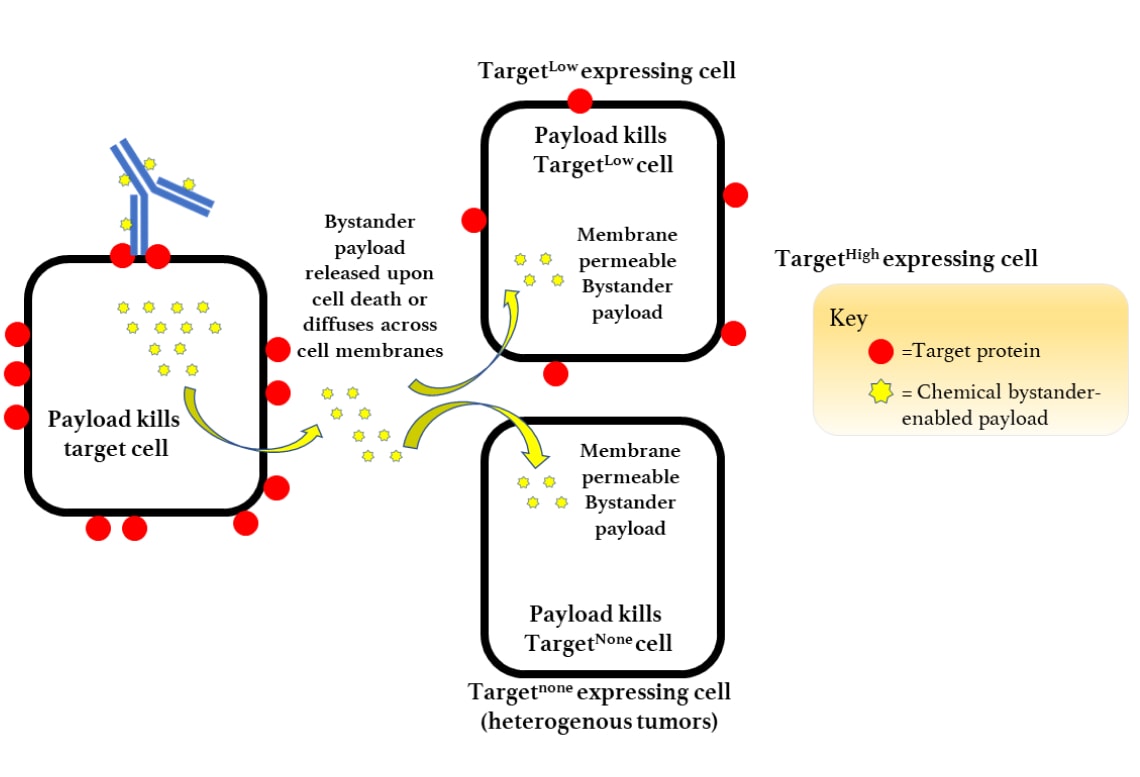.png/2023/10/10/6525cb95f1fef0ab4e1989fb)
What is ADCs?
ADCs are a class of anti-cancer agents that combine selectivity of monoclonal antibodies with the cytotoxic potential of small-molecule chemotherapeutics
ADCs work by targeting
An Antigen: protein targets that are present on cancer cell surface
With an Antibody: a large protein made by the immune system to seek out and destroy non-self antigens
Using a Linker: a chemical moiety that serves as a bridge and can be designed to immolate in the tumor cell/environment
This combination results in delivering a Payload/Toxin: a small molecule with sub-nanomolar potency against target cells
Why use ADCs?
Chemotherapies and targeted small molecules delivered systemically must be dosed until the target at the tumor site is saturated
Inability to focus treatment to the cancer target results in a) exposure to higher doses and b) off-target toxicity to other organs
ADCs reduce systemic exposure of payload by combining
- cancer-specific antigens
- high target specificity, affinity, and favorable pharmacokinetics of mAbs
- linkers responsive to tumor environment
Therefore, ADCs focus therapeutic delivery to cancer over normal cells improving the therapeutic index
>$22B
Growing ADC Market: >$22B by 2030
with Large Deal Flow
>$4B
Growing ADC Market: >Global Trop2 market expected to
surpass $4 billion by 2026
There continues to be concerns of off-target effects and toxicities with current ADCs and their respective Payloads
Systemic exposure of payload
(consequence of Bystander effect and/or Cleavable linkers)
Pro
Killing of low and heterogenous target-expressing tumors
Con
Off-target and/ or Systemic toxicity

Peak Bio has a platform of Best-in-Class
Approaches to expand the utility of ADCs
Current ADC approach
- Over 90% of current ADC payloads target tubulin or DNA (Processes essential to dividing cancer cells or their DNA)
- There is emerging resistance to these payloads
- Industry standard payloads are still associated with significant toxicities (see table above)
- Substrates of MDR(ABC) Transporters (Emerging drug resistance mechanisms)
Our novel, immuno-stimulatory payload approach
Spliceosome Modulation (PH-1)
- Targeting proper splicing of introns results in mRNA decay depriving cancer cells of essential proteins and mis-spliced proteins
- Creates neoepitopes for immune cells to target well after the initial “chemotherapy” is delivered
DNA mismatch repair (MMR) interference (PH-5)
- Prevent cancer cells from repairing mistakes during active DNA replication, thereby fixing the errors in translated proteins (neoepitopes)
Immune Suppression (PH-6)
- Killing tumor cells and pro-tumor immune cells that have been coopted
What makes our solution better?
- Enhances tumoricidal activity beyond cytotoxicity creating a potential Best-in-Class approach to treating cancer
- Engaging the host response (T and B cells) can co-evolve and can counter resistance mutations
- Payloads that act as poor substrate for MDR Transporters
- Immune memory can re-engage when treated cancers reoccur
Our Approach: Generation of Novel Toxins
Spliceosome Modulation (PH1)
- Disrupts alternative Splicing
- Deprives cancer cells of essential survival and growth factors
- Causes accumulation of mis-spliced proteins inducing tumor cell death
- Accumulates neoantigens recognized by immune cells as foreign proteins
- Synergizes with checkpoint inhibitors that alleviate suppression of immune cells

Novel or Validated Targets

Differentiated ADCs with improved safety/ efficacy profiles
Clinically validated Target (Trop2)
- Superior linker stability compared to an FDA approved competitor
- Superior specificity to cancer cells and unique ability to generate neoepitopes and synergizes with I/O therapies
- Anti-tumor immune memory
- Wide safety margin in non-human primate tox study
- IND-lead candidate chosen & 18-24 Month FIH
- De-risked antibody manufacturability
Our Solution
Immunostimulatory Payloads

Pros
- Killing of low and heterogenous target-expressing tumors
- Reduced off-target and/or systemic toxicity as catabolites are impermeable
- Long lasting immune memory
Cons
- May require alleviation of checkpoint inhibited immune cells in some tumors